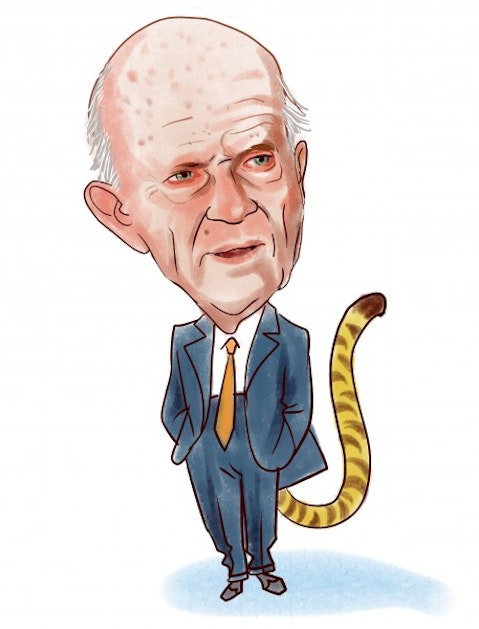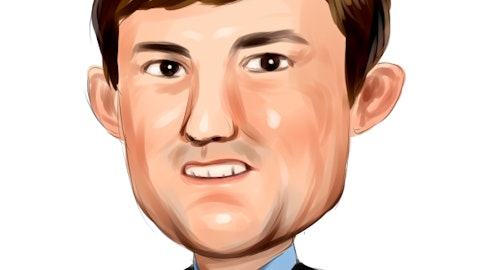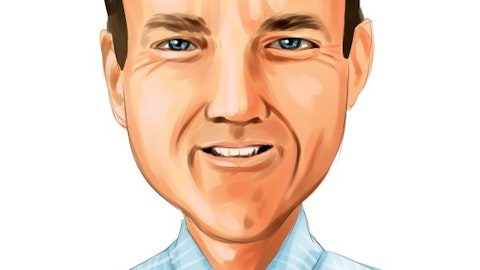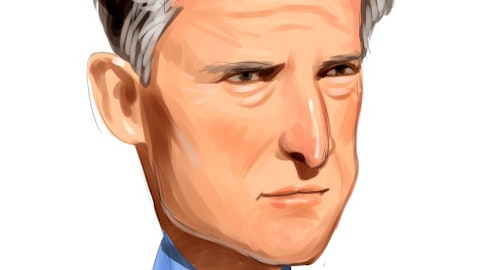Julian Robertson is a hedge fund legend. He stopped managing money for his clients more than 10 years ago, but he is still widely followed in the media and his comments attract a lot of attention. His stellar track record is to credit. Julian Robertson returned 31.7% per year after fees between 1980 and 1998, beating S&P 500’s 12.7% annual return by a huge margin. He performed terribly in 1999 and 2000 and his overall return went down to 26%.

Robertson is also a legend because the people who used to work for him went on to build their own stellar track records. Robertson’s Tiger cubs now manage more money than Robertson ever did. Blue Ridge Capital’s John Griffin, Tiger Global’s Chase Coleman, Maverick Capital’s Lee Ainslie are among these tiger cubs with amazing returns. As a group Robertson’s Tiger cubs returned 11.9 percent per year between 2000 and 2008, vs. an annual loss of 5.3 per year for the S&P 500 index. So, the Tiger cubs beat the S&P 500 index by more than 17 percentage points per year. Are Robertson’s Tiger cubs really this good?
Comparing raw return numbers may give you an idea about a hedge fund’s performance but you need to do an in-depth analysis to see the source of a hedge fund’s returns. Maybe, they owe their success to investing in high beta stocks in bull markets, or they consistently invest in value or momentum stocks. We obtained the Tiger Cub Index from Sebastian Mallaby’s book “More Money Than God”. The book is an excellent review of hedge funds’ history, full of profiles of hedge fund legends. Hennessee Group had returns for 18 of Julian Robertson’s Tiger cubs who worked for Robertson before 2000. The data include returns for two Tiger cub funds that blew up, so survivorship bias isn’t a big issue. Hennessee constructed the Tiger Cub Index and monthly returns are provided at the end of Mallaby’s book. It covers the 9 years between 2000 and 2008. We like that it covers 2008, which was a very challenging year for any fund.
We calculated Tiger cubs’ alpha for the entire 9 year period, for the first 6 years and the last 3 years using Carhart’s four factor model. Carhart’s model tries to dissect returns into four compartments: market return, size effect, value effect, and momentum effect. We pay special attention to the last 3 years for two reasons. First, it includes 2008. Second, hedge funds’ recent performances are better proxies for what they can deliver today. As hedge funds grow they can’t deliver at the same level because they can’t invest a large proportion of their portfolios in small cap stocks where the opportunities are larger. Previously, when we analyzed returns for several fund managers we noticed that their alphas went down as the funds get bigger and the hedge fund industry got bigger. After all, most hedge funds follow similar strategies and compete for the same stocks.
The tiger cubs’ alpha was 146 basis points per month between 2000 and 2005. Absolutely amazing. This is 19 percent per year. Tiger cubs had a market beta of 0.31 and invested in smaller stocks. They were also heavily invested in value stocks. These amazing returns explain why Tiger cubs flourished during the past decade. But do you think they managed to deliver the same returns after 2005?
Tiger cubs’ alpha was 39 basis points per month between 2006 an 2008. This is significantly less than their alpha in the earlier period. Still, this is a very respectable number. Tiger cubs’ investors managed to beat index funds (and exotic index funds too) by nearly 5 percentage points after paying fees and expenses. The return pattern we’ve observed with other hedge funds holds true here as well. Between 2006 and 2008, Tiger cubs had a market beta of 0.49 and didn’t have a small cap bias anymore. As they got bigger they started buying larger stocks and took on more market risk. They also switched to growth and momentum stocks.
We don’t have this index for 2009-2010, so we don’t know how their alpha changed during the past couple of years. The data we have indicate that Robertson’s Tiger cubs have around 4-5% annual alpha. Investors can benefit by imitating the following Tiger cubs whom Insider Monkey tracks and provides holdings for free:
John Griffin – Blue Ridge Capital
Andreas Halvorsen – Viking Global
Roberto Mignone – Bridger Management
Patrick McCormack – Tiger Consumer
Paul Touradji – Touradji Capital
Martin Hughes – Toscafund Asset Management
Philippe Laffont – Coatue Capital
David Gerstenhaber – Argonaut Capital
Rob Citrone – Discovery Capital Management
Arthur Cohen – Healthcor Management
John Lykouretzos – Hoplite Capital Management
Robert Bishop – Impala Asset Management
Steve Shapiro – Intrepid Capital Management
Kris Kristynik – Longhorn Capital
Tom Brown – Second Curve Capital
David Gallo – Valinor Management
Peter Palmedo – Sun Valley Gold (coming soon)




